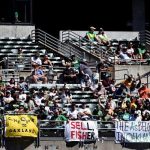Physical Address
304 North Cardinal St.
Dorchester Center, MA 02124
Physical Address
304 North Cardinal St.
Dorchester Center, MA 02124

WELLINGTON, New Zealand (AP) — A collection of artworks claimed to be by Pablo Picasso and other renowned artists ignited debates and legal battles. These artworks, displayed at an Australian art museum in an exhibition accessible exclusively to women, led to a lawsuit citing gender discrimination. The controversy intensified when the gallery found a loophole to rehang the pieces in a women’s restroom after a court decision barred the exclusion of men from viewing them.
This week, however, the situation took another twist. Kirsha Kaechele, the curator behind the women-only exhibition, confessed that she had painted the artworks herself. The revelation was prompted by inquiries from a journalist and the Picasso Administration in France questioning the authenticity of the pieces.
Kaechele shared on the blog of Tasmania’s Museum of Old and New Art (MONA) that no questions about their provenance arose for over three years, even though one of the fake paintings had mistakenly been hung upside down. “I imagined that a Picasso scholar, or maybe just a Picasso fan, or maybe just someone who googles things, would visit the Ladies Lounge and see that the painting was upside down and expose me on social media,” she wrote. Surprisingly, no one did.
The journey of these artworks began in 2020 when Kaechele established a women-only area at MONA, designed for women visitors to enjoy each other’s company and highlight their historical exclusion from male-dominated spaces. The Ladies Lounge featured high tea, massages, and champagne served by male butlers, and welcomed anyone who identified as a woman. Alongside the fake paintings were bizarre and absurd title cards, and displayed items such as antiquities and jewelry that were “quite obviously new and in some cases plastic,” Kaechele explained.
To emphasize the exclusion of men, Kaechele felt the exhibit needed to feature “the most important artworks in the world.” This strategy seemed effective when a male gallery patron’s complaint about being barred led the Tasmanian Civil and Administrative Tribunal to order MONA in March to stop excluding men from the exhibit.
Tribunal Deputy President Richard Grueber’s decision stated that the entry process itself was part of the artwork, yet he found the exhibition discriminatory. Grueber noted that the exclusion was particularly disadvantageous because of the supposedly high-value paintings in the Ladies Lounge. Kaechele had asserted during the tribunal that the exhibit featured prominent works, including two that demonstrated Picasso’s genius.
Grueber also criticized a group of women who attended the tribunal hearing in matching business attire, silently crossing and uncrossing their legs in unison. One woman was seen pointedly reading feminist texts, and the group left the tribunal “in a slow march led by Ms Kaechele to the sounds of a Robert Palmer song.” Grueber described their behavior as “inappropriate, discourteous and disrespectful, and at worst contumelious and contemptuous.”
Instead of opening the exhibit to men, Kaechele converted the space into a working restroom, exploiting a legal loophole to continue excluding men. Despite coverage from international news outlets in May that didn’t question the presence of Picasso paintings in a public restroom, The Guardian asked Kaechele about the authenticity of the artworks, leading to her admission.
A spokesperson for MONA, Sara Gates-Matthews, acknowledged that Kaechele’s blog post titled “Art is Not Truth: Pablo Picasso” was genuine, confirming its accuracy. However, MONA withheld further details regarding the letter from the Picasso Administration, and the Picasso Administration did not respond to requests for comment.
Kaechele expressed her surprise at the belief in her fabricated story, which included an exaggerated tale of her great-grandmother’s interaction with Picasso. She remarked, “I’m flattered that people believed my great-grandmother summered with Picasso at her Swiss chateau where he and my grandmother were lovers when she threw a plate at him for indiscretions (of a kind) that bounced off his head and resulted in the crack you see inching through the gold ceramic plate in the Ladies Lounge.” Her whimsical narrative emphasized the supposed origins of one of the exhibit’s pieces.
“The real plate would have killed him — it was made of solid gold. Well, it would have dented his forehead because the real plate is actually a coin.” Kaechele concluded her confession with this imaginative statement, further underscoring the exhibit’s playful and critical nature.
Source: The Associated Press, The Guardian



